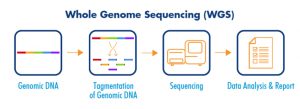Whole genome sequencing (WGS) is the most global approach to identifying genetic variations. Whole genome sequencing or full genome sequencing, is the process of determining the entirety of the DNA sequence of an organism’s genome at a single time. Genomic information has been instrumental in identifying inherited disorders, characterizing the mutations that drive cancer progression, and tracking disease outbreaks. This entails sequencing all of an organism’s chromosomal DNA as well as DNA contained in the mitochondria and, for plants, in the chloroplast. Whole genome sequencing has largely been used as a research. In the future of personalized medicine, whole genome sequence data may be an important tool to guide therapeutic intervention.
Advantages of Whole-Genome Sequencing
- Provides a high-resolution, base-by-base view of the genome
- Captures both large and small variants that might be missed with targeted approaches
- Identifies potential causative variants for further follow-up studies of gene expression and regulation mechanisms
- Delivers large volumes of data in a short amount of time to support assembly of novel genomes
Next generation sequencing
The feasibility of WGS analysis is under the support of next generation sequencing (NGS) technologies, which require substantial computational and biomedical resources to acquire and analyze large and complex sequence data. Meanwhile, the rapid progress and innovation of NGS technology has successfully enabled the generation of large volumes of sequence data and reduced the expense for WGS. While WGS method is commonly associated with sequencing human genomes, the scalable, flexible nature of next-generation sequencing (NGS) technology makes it equally useful for sequencing any species, such as agriculturally important livestock, plants, or disease-related microbes.


